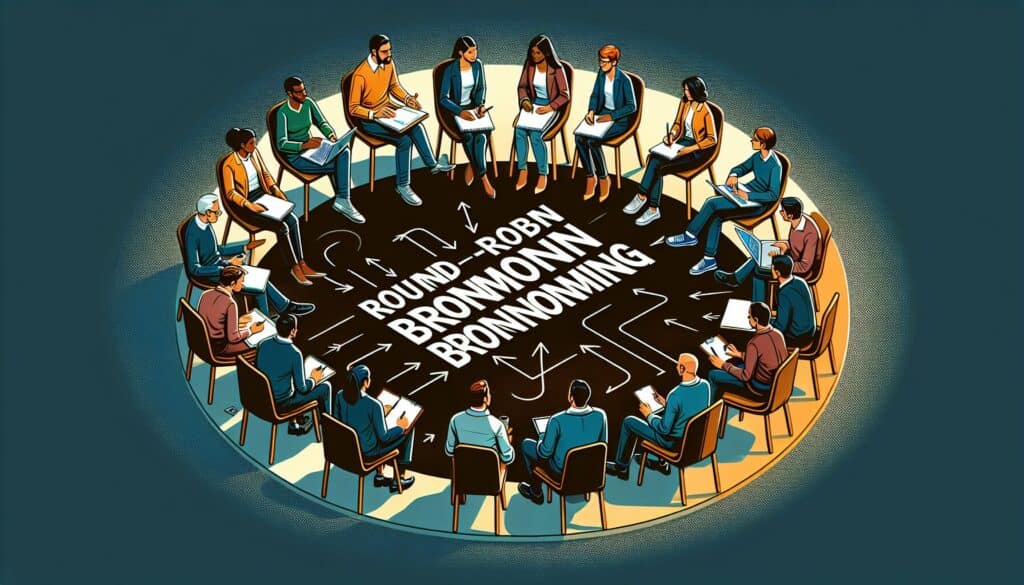A structured brainstorming method where participants share ideas one at a time in an orderly fashion.
- Methodologies: Customers & Marketing, Ideation, Product Design
Round-Robin Brainstorming

Round-Robin Brainstorming
- Agile Methodology, Brainstorming, Continuous Improvement, Creativity, Cross-Functional Collaboration, Design Thinking, Ideation, Teamwork, User-Centered Design
Objective:
How it’s used:
- Each person in a group takes a turn to contribute an idea. This continues in rounds. If someone doesn't have an idea on their turn, they can pass, but can contribute in the next round.
Pros
- Ensures equal participation and prevents a few individuals from dominating; generates a large number of ideas; can be less intimidating for quieter members.
Cons
- Can feel slow or rigid compared to open brainstorming; ideas shared later might be influenced by earlier ones; pressure to contribute on each turn might stifle some.
Categories:
- Ideation, Problem Solving
Best for:
- Generating ideas in a group setting while ensuring everyone has an equal opportunity to contribute.
Round-Robin Brainstorming is especially effective in industries such as product design, software development, and marketing, where diverse perspectives can lead to more innovative solutions. This methodology is particularly beneficial during the ideation phase of a project, where generating a variety of ideas is crucial for creative problem-solving. It can be initiated by a project manager or team leader, and participants typically include members from various departments, such as engineering, design, marketing, and research, ensuring a broad range of viewpoints. The structured nature of Round-Robin Brainstorming encourages quieter team members to voice their ideas without the pressure of competing in an unstructured environment, thus enhancing inclusivity. It is also useful in educational settings, where students can practice collaborative skills by contributing ideas in an orderly manner. The method can be adapted for hybrid teams by using digital platforms that allow for virtual turns, thus maintaining participation across geographic boundaries. This approach not only generates a wealth of ideas but also fosters team cohesion as members build off each other’s suggestions, leading to a richer creative process and more robust solutions.
Key steps of this methodology
- Start the first round and ask each participant to share one idea in turn.
- Encourage building on previous ideas during each person's turn.
- Continue rounds until every participant has shared or passed twice.
- Maintain an open floor for voluntary contributions or elaborations after completing rounds.
- Use a timer to keep the pace and ensure everyone has a chance to contribute.
Pro Tips
- Rotate the facilitator role for each round to encourage leadership and diverse perspectives.
- Before starting, establish clear objectives to guide the discussion towards relevant and actionable ideas.
- Incorporate a time limit for each contribution to maintain momentum and reduce downtime between ideas.
To read and compare several methodologies, we recommend the
> Extensive Methodologies Repository <
together with the 400+ other methodologies.
Your comments on this methodology or additional info are welcome on the comment section below ↓ , so as any engineering-related ideas or links.
Historical Context
1960
1980
1983
1990
1995
2000
2010
1950
1980
1980
1986
1994
1995
2000
(if date is unknown or not relevant, e.g. "fluid mechanics", a rounded estimation of its notable emergence is provided)














Related Posts
Manufacturing Operations Management (MOM)
Manufacturing Execution System (MES)
Manufacturing Control Plan
Manual Testing
Manual Handling Assessment Charts (MAC)
ManTRA (Manual Tasks Risk Assessment Tool)